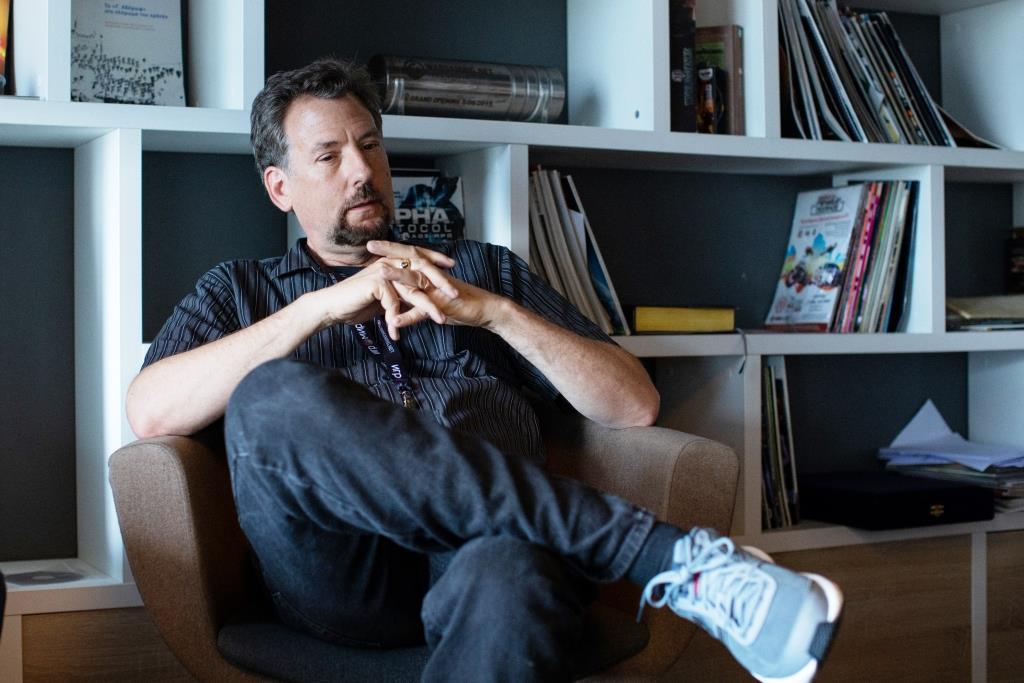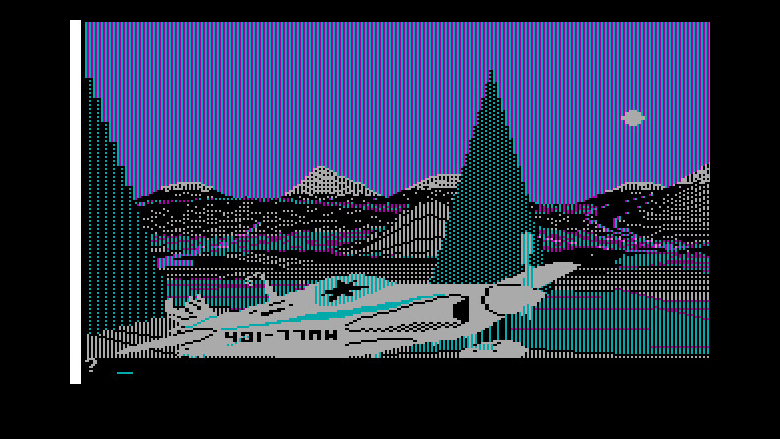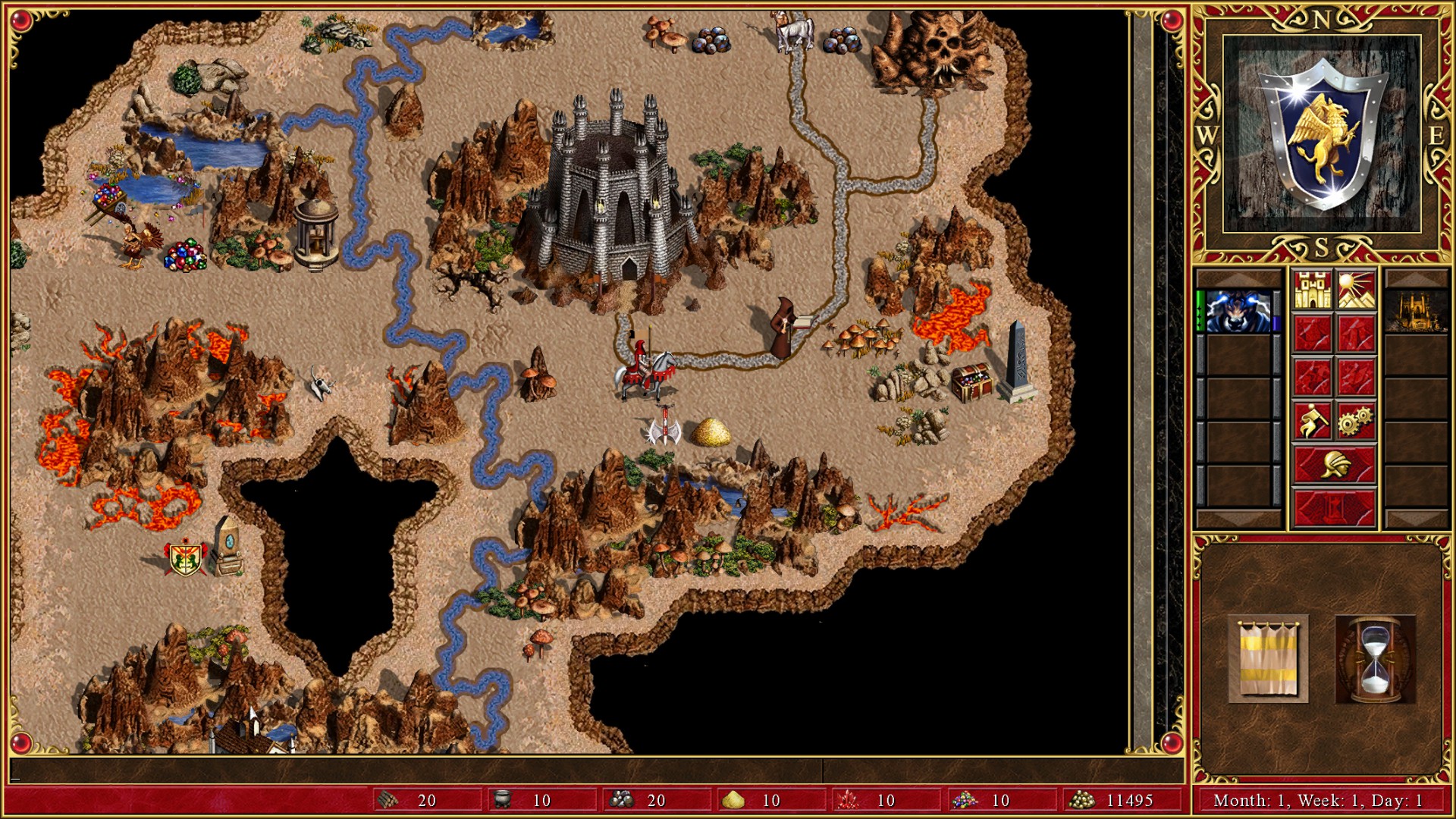The expression “industry veteran” is used too liberally these days. We are quick to call anybody “veteran” who has a couple of decades of experience. What does it make David Mullich, the man who has been making games or teaching about games for 40 years? And it’s not just any games. David created or was involved in creating the legendary titles like I Have No Mouth, and I Must Scream, Vampire: The Masquerade – Bloodlines, and, of course, Heroes of Might and Magic III.
Last week, the developers from Wargaming Mobile invited David to their studio in Minsk, Belarus, to talk about his projects and share his experience with the staff and the game development community. We caught up with David between his lectures and workshops.

David Mullich. Image credit: Wargaming
GWO: David, you’ve got 4 decades of experience in gaming, tried various roles, fathered a number of projects that have a cult following. It’s like the industry matured on your watch. How would you say the industry is different today from its early days?
David: In some ways, it’s different, in some ways, it’s the same.
When I started off, individual developers really struggled to get distribution. Big publishers started forming, and it was getting harder and harder to introduce innovative new products.
These days, the industry has almost gone full circle. With indie developers, there’s that pioneering spirit again. Thanks to Steam and other distribution platforms, it’s possible to come up with unique products and get your own vision out. But now you are in competition with all these other game developers out there. To get your game noticed, you have to beat all the competition. When I started out, there were very few of us. Now just about anyone could be a game developer. That’s probably the biggest change these days.
GWO: What’s your take on the rise of mobile and games becoming live services? Would you say, the industry is departing from its creative roots?
David: The games-as-a-service model doesn’t take away from the creative roots. You have to come up with creative ways to keep your game engaging for a long period of time. That involves continual creativity.
The challenge, though, with games-as-a-service is to figure out how you can justify continual charges, all the little micro-transactions along the way. Players shouldn’t feel like the game is going out of its way to pick their pockets. The trick is to find a seamless and organic way to provide an experience that players feel good about paying for. And that’s something we are still struggling with.
GWO: Then again, if a game is too engaging, it’s easy to forget about the real world – something that the WHO is concerned about. The discussion around “gaming disorder” has also become a staple of the modern video game industry.
David: Any pleasurable experience can turn into compulsion. There were some games I played where I got so into them I had to be very careful to make sure I didn’t neglect other things. It takes a certain amount of willpower. But it can be a problem for some people who play compulsively. Or drink. Or gamble. That’s something we should be aware of and be sympathetic about. I am actually ok with the idea of treating people who play compulsively. Games can be pleasurable experiences, we don’t want them to become destructive ones.
GWO: But with your games, you have never settled for just “pleasurable.” Like 1986 game Wilderness: A Survival Adventure (1986) which you worked on as a producer. It almost became the prerequisite for BSA’s Wilderness Survival Merit Badge. And, of course, The Prisoner (1980). Wikipedia says, the CIA used it as a training tool. Is it true, by the way?
David: That’s what I’ve heard. But I am not sure I have heard it from a very reliable narrator.

Wilderness: A Survival Adventure (1986)
GWO: …Anyway, with your games, have you always tried to go beyond entertainment?
David: In all my games, I try to create an experience that goes deeper than that. Sometimes, there is educational value to it. Sometimes, it’s about making the player step into the shoes of another person. It’s about creating an experience that is compelling, but not necessarily fun. With The Prisoner, I was trying to create the experience from the television show that inspired it. I wanted players to feel like they are constantly being frustrated, they are constantly losing, things are out of their control. But I also wanted to keep this experience engaging. That’s what I tried to do. Create an unusual rich experience that may not be entertaining, but still feels worthwhile. So that player could get something out of it. Not just something they would play to pass the time.
GWO: But that’s expressly what many game studios go for. Create fun games that people would play to pass the time. Did you specifically try to break the gaming conventions?
David: That’s exactly what I tried to do with The Prisoner. I looked at the games around it at the time. They all seemed to follow the same template. I wanted to create a game that broke all the rules. And I think I succeeded.
I was hoping it would inspire people to make creative games. Instead, the industry adopted very entrenched game genres, like first-person shooter, real-time strategy, and adventure games. All of which tend to have the same type of goals, the same type of actions to perform, the same type of rules.
I wish there were more creativity and more people who would explore what games mean, what kind of experiences you can create with games. A lot of indie developers are doing it. But the problem with experimenting is that it’s risky, and the big developers have a problem taking risks. It’s understandable because games cost so much money to make. So big studios have to follow things that are already successful.
I would like to see more indie developers take risks that pay off well. Over time it will inspire bigger studios to follow in their footsteps.

The Prisoner (1980)
GWO: And what inspired you to make The Prisoner, one of the most unusual games out there?
David: Before I made The Prisoner, I took a psychology class in college. I was very impressed by the psychological experiments we heard about. For example, people were placed in a room, and there was a rope tied to each end of the room. The rope was then cut with a pair of scissors, and the task was to connect these pieces of rope back together. Of course, those pieces would just barely match. The secret to tying them together was to use the scissors not just for cutting, but to use them as a clamp. It was a case of using a tool for the opposite purpose than the one it was originally intended for. And that’s what inspired me. I wanted to make a game which did things the opposite way than you expected. That’s how many mechanics in The Prisoner came out to be.
GWO: You were a producer on another highly unusual project that enjoys a cult status. I Have No Mouth, and I Must Scream (1995) was born out of marriage between literature and game design. What was it like working with Harlan Ellison, the author of the original 1967 story with the same name?
David: The game started before I was involved. Cyberdreams, which was the publisher, signed the deal with Harlan Ellison to adapt his short story. At first, they hired a game designer named David Sears to work on the project. One year, Harlan and David appeared at the annual Game Developers Conference to promote the game. I was attending the conference that year. As I watched their presentation, I felt very jealous of David Sears. I thought I should be working on this game. I Have No Mouth, and I Must Scream was my favourite story of all time. And having made The Prisoner, I thought I would be the perfect person to be producing it.
As it turned out, David Sears left the project fairly early on. He just barely started working on the game design document. And Patrick Ketchum, who was the founder of Cyberdreams, called me up. He asked if I was interested in being a producer of that game. Boy, would I!
The company I was working for was going out of business, so I was available. I joined Cyberdreams, and I went to Harlan’s house to meet him for the very first time. In his eyes, I was the latest in the stream of the people from Cyberdreams that were attached to this project. As soon as I walked through his door, he just started cursing at me, calling me names. “Another of those stupid Cyberdreams people,” something like that.
I knew what type of person Harlan was, I heard he was difficult to work with. So I didn’t let it bother me. I just let all these insults bounce off me. And then I sat with him in his kitchen. I explained to him that it was my favorite short story and that I would do his story justice. I told him about The Prisoner, which was also a game that I tried to approach as a form of literature.
Harlan didn’t know anything about video games. He wanted someone who would pay attention to him and really sympathize with his integrity as a writer. And the more I talked, the more he saw that I was someone who would treat his story well.

I Have No Mouth, and I Must Scream (1995)
We started working closely together. The design that I inherited from David Sears was incomplete. It was maybe one fifth of what the final game turned out to be. About one fifth of the dialogue for the game was written. The problem was Harlan was too busy to write the rest of the dialogue himself. So I wound up writing most of the game’s dialogue. Even though I thought of myself as a very creative person and I enjoy writing, I am not a Harlan Ellison. And I remember bringing him the first scenario I’ve written, the first full dialogue for the game, with all the different choices players could make that affected the dialogue. So I showed him my script, he read through it and said to me:
“Who wrote this shit?”
“I did.”
He got really embarrassed.
“Oh my god. I didn’t realize it was you.”
“Harlan, that’s ok. I am not you. Compared to you, this IS shit. So what I want you to do is to go and make it better.”
He took it, went into his office and 45 minutes later he came back with the script. Unfortunately, he didn’t have the chance to polish everything. So I tried to emulate his style for writing the rest of it. And that got me into some deep dark places.
During that time, my newborn son was diagnosed with cancer, he spent a lot of time in the hospital. It was bad for myself and my wife. But I tried to take all that anguish and channel it into my writing.
One night, I was writing the scenario where one of the characters, Ellen, confronts her rapist from before and deals with the terror of that. Of course, I am not a woman. I don’t know what it’s like to be raped or confront a rapist. But when I was writing this piece of dialogue in the middle of the night, all by myself, at home, after my wife had gone to bed, I imagined myself confronting cancer that infected my child and how I would deal with that. And that’s what inspired me to write this bit of dialogue.
The thing that satisfied me most about this game was being able to put myself in the right mindset to create that kind of horror. I tried to do the same with the rest of the dialogue. And I was very pleased with how people reacted to the final product. I don’t think it was very obvious which parts were written by Harlan, and which by me. It was pretty seamless.
GWO: David, you were also a game director on Heroes of Might and Magic 3, which remains a much beloved title to this day. What was the magic behind making it? What kind of stars aligned that didn’t necessarily align for the other entries?
David: The magic was the team behind it. Game designer Gregory Fulton. Art director Phelan Sykes. John Bolton, who was the technical director. And Rob King, who wrote the music. Everything came together very well. And, of course, we were inspired by Jon Van Caneghem’s work on previous games in the series.

Heroes of Might and Magic III: The Restoration of Erathia (1999) – HD Edition (2015)
HoMM2 won all sorts of awards for the best turn-based strategy game of the year. When New World approached me about working on HoMM3, I thought: “How can I possibly top this?”
Well, as it turned out, as we expanded it, fleshed out the design, added a couple of new towns, created our own storylines for them, we managed to bring it closer to the sweet spot. Basically, we took a very good game and made it an even greater game. It was a case of adding the right amount of extra. We pushed a really good concept even further without pushing it too far. But in the end, it was just a good team really firing on all our cylinders.
GWO: Having been in so many roles… You wrote and designed the Prisoner, you were Game Director for the Heroes, Producer for Vampire: The Masquerade – Bloodlines… What role gave you the most satisfaction and why?
David: Oh, that’s always hard to say. I worked as a programmer, a designer, and a producer in charge of a team, I worked with outside developers on behalf of a publisher. I really enjoyed designing my own games. But if you are talking about overall satisfaction, I have to go back to Heroes 3. Leading that team… There’s nothing more satisfying than working with a group of talented people.
GWO: And you would think the more experience, the better. But, as you wrote in one of your blog posts, that had not always been the case for you. You did get several rejections for the positions you interviewed for because of your age. Do you feel like ageism is an issue today in that industry?
David: To be honest, when I was young and worked in the game industry, I myself didn’t always hire promising team members because I was too focused on whether we could be friends with them. Early on in the game industry, we were all friends with each other, we would go out together after work. I don’t think I appreciated professionalism enough and some of the expertise that comes with it.
What happened with me was that people would bring me in for an interview and then realize that I’m ten year older than them. They would tell me: “Everything who works here is very young.” That’s one of the obvious indicators of ageism. It’s very hard to be taken seriously for guys like me and women who are older. They have the double problem of sexist attitudes and ageism.
We really ought to work together to look past that and consider what talents people have. The very fact that they ARE different can be an excellent asset for the team as they would bring in these different viewpoints.
GWO: And what are you working on these days?
David: I’m mostly focused on education. I also do consulting both at my own and through Say Design, a company based in Thailand. We are working on some projects, but unfortunately, I can’t talk about them.
GWO: David, we wish you another 40 years of inspiring and unconventional experiences in games and education. Thank you for your time.
